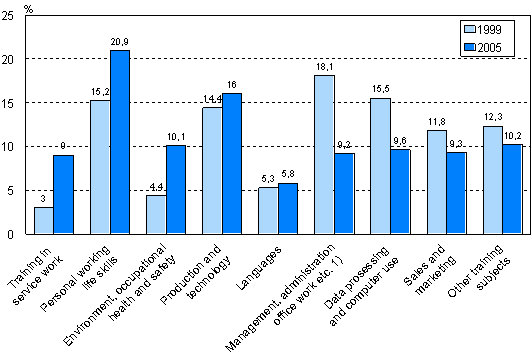4. Point of emphasis in contents of training is changing
Training connected with mastery of the technical aspects and contents of a profession has been making up a diminishing share of all personnel training in recent years. Whereas in 1999, training connected with increasing or maintenance of professional skills and competence accounted for approximately 68 per cent of all course training hours, the respective share was almost 10 percentage points lower in 2005.
From professional knowledge to working life skills
During the examined six years, the emphasis in the training offered by enterprises to their personnel has shifted somewhat from the development of professional skills to the improvement of the general skills needed in working life and work communities. However, it should be borne in mind here that quantitative input into the development of general working life skills has not increased since 1999. Because the volume of personnel training has diminished fairly clearly, a question of a shift in priorities is concerned.
Two dimensions of contents of training
| Field of training | 1999 | 2005 |
| Training subjects maintaining professional skills – Training related to production and technology – Data processing and information technology – Languages – Sales and marketing – Management, administration, office work, bookkeeping and accounting – Training connected with service work 1) |
68,1 | 58,8 |
| General training subjects connected with work and profession
– Personal working life skills, such as co-operative and presentation skills, corporate knowledge, development and organisation skills. – Environmental protection, occupational health and safety |
19,1 | 31,0 |
| Other training fields | 12,3 | 10,2 |
| Total | 100,0 | 100,0 |
The contents of the category of personal working life skills are relatively clear. It comprises general training promoting the preparedness for working life, development in work and coping at work that are not associated with any specific occupation or field of occupation. In Adult Education Survey that is based on personal interviews the titles of the courses in this category include e.g. quality training, process of change, team coaching, planning work training, working life training, work community training, promotion of working skills, co-operative skills training, time management, presentation skills, human relations skills and career planning (Participation in Adult Education, Adult Education Survey 2006, Statistics Finland, Education 2008).
Environmental protection, and occupational health and safety is a slightly more complex field of training. In Adult Education Survey this category includes both general training to improve readiness for working life, such as occupational well-being, labour protection, work atmosphere training and occupational safety, and courses relating to specific occupations or occupational fields, such as occupational health care, information security training, electrical industrial safety, fire safety training, hygiene training or hot work training.
The fluctuation in the quantitative development of training can be assumed to be linked with the market and labour market situation, and with different technological or economic phases in various industries. However, due to the continuously changing working life the need to train employees is unlikely to diminish even in future.
Due to the generally risen educational level the basic readiness of employees for their occupations has improved and enterprises’ training practices reflect this change. As the new age groups start entering working life there is no longer the same need to invest in basic information technology skills as before. Employees with longer work histories have mainly already received the basic training required by the new working tools. Thus, input into information technology skills has diminished in personnel training in both absolute and relative terms.
Figure 8. Contents of training by field of training in 1999 and 2005 (In order of change in relative share)

1) In 1999, management, administration and office work were training fields of their own (total 13.5%). In 2005, they were included in the training field of bookkeeping and accounting.
The same also partly goes for foreign language training, although the globalisation of enterprises and the labour force still continues to require foreign language skills from an increasing number of employees in their day-to-day work. The relative proportion of foreign language training of personnel training has remained unchanged although its volume has fallen since 1999 whether measured with participation rate or received training hours.
The data on the shift in the point of emphasis in course format personnel training are congruent with those of Adult Education Survey. According to Adult Education Survey, the proportion of participants in personnel training in computer use and information technology diminished by approximately ten percentage points from 2000 to 2005. By contrast, the share of participants in language training remained on level with 2000 in 2006 (Adult Education Survey 2006).
Source: CVTS, Continuing vocational training survey, Statistics Finland
Inquiries: Hannu Virtanen 09–1734 2514, Tarja Seppänen 09–1734 3220
Director in charge: Riitta Harala
Updated 8.5.2009
Official Statistics of Finland (OSF):
CVTS, Continuing vocational training [e-publication].
ISSN=1798-0003. Participation in course-format training 2005,
4. Point of emphasis in contents of training is changing
. Helsinki: Statistics Finland [referred: 19.4.2025].
Access method: http://stat.fi/til/cvts/2005/02/cvts_2005_02_2009-05-08_kat_004_en.html

